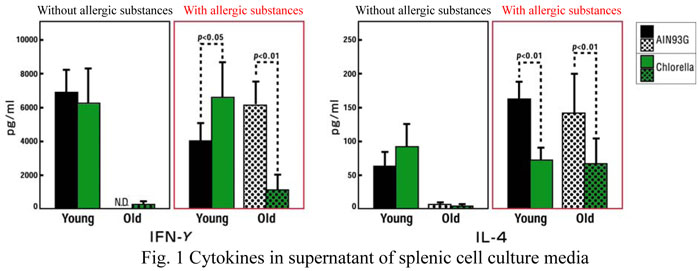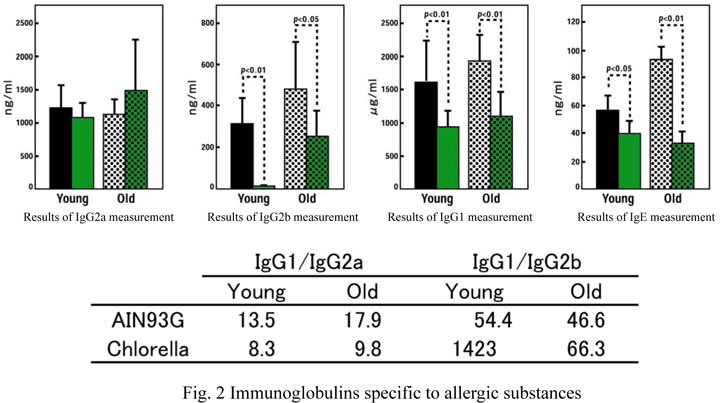- TOP
- List of reports
- Suppression of aging of immune function and prevention of allergy in mice given
chlorella for a prolonged period of time
Suppression of aging of immune function and prevention of allergy in mice given Chlorella for a prolonged period of time
【Scientific information】
Research and Development Department, Sun Chlorella Corporation
Suppression of aging of immune function and prevention of allergy in mice given chlorella for a prolonged period of time
Presented at the 63rd Annual Meeting of the Japanese Society of Nutrition and Food Science (2009) and the 2009 Annual Meeting of the Japanese Association for Food Immunology
- Study Objectives
- As individuals grow older, their immunity declines and the incidence of infectious disease in them increases. In addition, enhancement of resistance to allergic substances, or not producing excessive antibodies in other words, leads to the prevention of allergy. It is thus important to prevent the decline in immunity associated with age and enhance resistance to allergic substances irrespective of patient age. Improvement of metabolic syndrome, prevention of arteriosclerosis, and improvement of immunoregulatory function under stress have also been reported as effects of chlorella. However, the effects of prolonged ingestion of chlorella on immunity have yet to be reported. We examined the effects of prolonged administration of chlorella to mice on resistance to allergic substances and compromised immune function.
- Method and experiments
- Animals were either given basic food (AIN93G) (control) or basic food mixed with chlorella at 2%. They were divided into a young group, in which animals were given food for 4 – 10 weeks, and an aged group, in which animals were given food for 4 – 50 weeks. Animals were given ovalbumin as an allergen. A total of 8 groups of animals were included in the study. After the feeding periods noted above for each group, 4 types of immunoglobulins specific to allergens in blood and 2 types of cytokines in splenic cells were measured after blood samples were obtained and the spleen was excised.
- Results
(1)
Cytokines in supernatant of splenic cell culture media (Fig. 1) In the case of chlorella administration, levels of production of IFN- and IL-4 in the young animal group to which allergens were given were similar to those in the young animal group to which allergens were not given. In addition, production of IFN- was observed in the old animal group to which allergens were not given. Furthermore, production of IFN- and IL-4 was in the case of chlorella administration significantly lower in the old animal groups to which allergens were given than in the control group. These findings suggested that aging of immune function was suppressed by chlorella ingestion.
(2)
Measurement of immunoglobulins specific to allergens (Fig. 2) There were significant decreases in production of IgG2b, IgG1, and IgE in the chlorella group irrespective of animal age. In addition, on calculation of indices of Th2/Th1 balance, IgG1/IgG2a ratio was markedly elevated and IgG1/IgG2b ratio markedly decreased in the old 3-2 animal groups. However, while IgG1/IgG2a ratio was only modestly increased, IgG1/IgG2b ratio was greatly increased in the old animal groups compared with the control group. These findings suggested that chlorella ingestion increased resistance to allergic substances.
- The findings indicated above thus suggested that aging of immune function was suppressed and resistance to allergic substances was enhanced by chlorella ingestion.


Presentation at a scientific meeting
- Name of meeting:
- 63rd Annual Meeting of the Japanese Society of Nutrition and Food Science, 2009 2009 Annual Meeting of the Japanese Association for Food Immunology
- Title:
- Effects of chlorella on allergen exposure and aging of immune function in mice given chlorella for a prolonged period of time
- Presenters:
- ○Masaki Fujishima1), Yukari Arakawa1), Toru Mizoguchi1), and Tohru Masuzawa 2)
- Affiliation:
- 1) Sun Chlorella Corporation, 2) New Drug Development Research Center, Inc.





